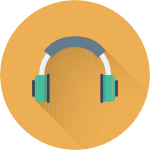
Ear training can transform the way you experience music. But it took me years to figure out how. I did all the tests, apps and exercises, but it never really felt like it was impacting my playing.
I got better at the exercises eventually, but that seemed more like a fun (although very nerdy) party trick than an essential musical skill.

As I learned the hard way, there is a right and a wrong approach to ear training. It’s the difference between one of the most rewarding and liberating things you’ll ever learn and a frustrating waste of time. I’m writing this article so you can avoid the mistakes I’ve made, and skip right to ear training awesomeness.
Here are some of the questions I’ll help you clear up. Why exactly is ear training important? How will trained ears help you make better music? What is the best way to train your ears? And how does music theory fit into all of this?
CHAPTER 1
Why ear training is awesome
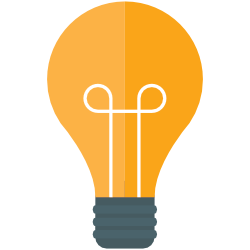
Here are some situations where ear training will help you:
- You’re rehearsing with your band when one of your friends starts playing a riff or chord progression you really like. A guitar melody pops into your head that would fit perfectly with it, so you jump right in and play it.
- You want to learn some of your favourite music. Instead of having to look up sheet music or guitar TAB, you can simply sit down with your instrument and figure out how to play that music. This is especially great when you want to learn music by some obscure band, a solo from a live recording or part of a movie or video game soundtrack, for which there isn’t any notation available.
- You’re on the bus or train, away from your instrument, and a beautiful melody or kick-ass riff occurs to you. You know you’ll forget if you wait until you get home. So instead of making a crappy recording of it by awkwardly humming it into your phone, you quickly jot down your musical idea, knowing that you can now return to it whenever you feel like it.
These are just a couple of examples of course. Speaking more generally, we can say this:
Ear training will change, improve and enrich your entire experience of playing and listening to music.
I don’t like keeping things wishy-washy, so let’s take a closer look at what this means. How exactly does ear training change your experience of music? To answer this, we need to take a look at the three core abilities that ear training helps you develop.
CHAPTER 2
Three core ear training abilities

For the first six months of their lives, babies listen to the people around them. Next, they start engaging in ‘speech babble’ as they try to reproduce the sounds they’ve heard. As babies grow into kids, they learn how to speak and are able to have conversations about things like their favourite color or how their day was. Only when kids have reached that level, we teach them the alphabet, grammar and how to read and write.
Summing up, we can roughly define three stages:
1. Listen 2. Speak 3. Read and write
What’s remarkable about this is that children learn language and first learn how to speak without any idea of the underlying grammar. Their English is close to 99% perfect without consciously knowing anything about grammar. They might not know what verbs, adjectives and prepositions are, but they know how to use them nearly flawlessly. Then when they do learn grammar, they discover that there are certain rules that they’ve been using unconsciously for years.
According to Edwin E. Gordon and musicians like Victor Wooten, it makes a lot of sense to learn music in a similar way. That means we should start by listening. And we do. The reason you started to play an instrument, was because you heard a bunch of music and you liked it. In fact, you’ve listened to thousands of hours of music.
Step two is the musical equivalent of listening and speaking: listening to music, hearing it in your mind and then getting the sound you hear ‘internally’ out of your instrument. Like the kids using the sounds and words they’ve heard around them, we musicians should try to reproduce the music we’ve been listening to. Gordon calls this ability to hear music in our head 'audiation'. In his view, it is the foundation of musicianship: 'Audiation is to music what thought is to speech.'
The third step is to learn to read and write. For musicians, this means learning music theory. We need to learn about things like quarter notes and eighth notes, about keys and scales and about how chords are constructed.
These three steps conform perfectly to the three core abilities that we’re developing with ear training. Let’s look at each of them in some more detail.
CHAPTER 3
Hearing in 'HD'
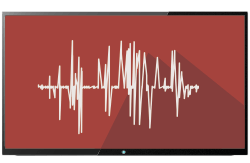
Developing this skill will profoundly change the way you experience music as a listener. One student of mine had practiced a lot of ear training and described it like this. "When I listen to music now, I can hear different things than I could before. It’s like listening to a new song."
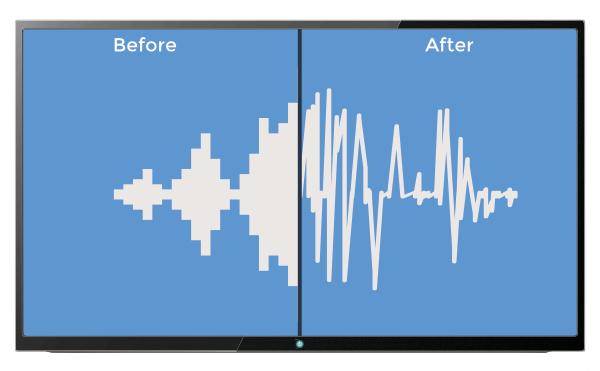
So what exactly does this all mean in practice? Here are some examples. Where fast guitar licks might sound like a blur of notes at first, as your ears develop, you’ll be able to pick out each one of those notes. You’ll also be able to pick out every instrument, even the ones that aren’t as prominent in the mix. Another striking example is the ability to hear the bass guitar. Experienced musicians find this obvious, while newer players and non-musicians can really struggle to hear the bass at all.
Pretty much every exercise listed in chapter 7 below will help you develop this skill, though learning songs by ear (exercise 1 below in chapter 7) is definitely the most effective.
You can also train this ability simply by carefully listening to a recording. Take a song that you’ve been listening to recently. How many different instruments do you hear? And what are all those instruments playing? Which instruments are loud and which ones are more subtle? For example, what pattern is the bass drum playing? And can you tune into the lower instruments such as a bass guitar?
Whenever you listen to music with your full attention, you’re training your ability to hear in greater detail.
CHAPTER 4
Playing by Ear

If you think of music as a language, this skill is like being able to say whatever comes to mind, whereas what we often do is recite a speech we’ve memorised. This is why playing by ear is key to becoming a good improviser. It allows you to let musical ideas flow from your head through your fingers. This also makes jamming with fellow musicians a lot of fun. Similar to having a conversation, you’ll be able to listen to what others playing and respond in a musically meaningful way. (For more on improvisation, check out this guide.)
What’s striking about this skill is that it feels very intuitive and automatic once you’ve developed it. You hear a melody and your hands just do whatever they need to do to get that melody out of your instrument, just like your vocal cords do what they need to do to hum a song you’ve just heard. That doesn’t mean this ability is magical though. Like most musical skills, it's simply a matter of practice. In fact, you already possess this skill to an extent.
Say I ask you to play the 5th fret of the b string. Then I play another note without allowing you to look at my fretboard and ask you to play that note. You hear that the second note is slightly higher. Intuitively, you know that you won’t have to go much higher up the neck to play that note, but just a couple of frets. The only thing you’re not sure about is how many frets exactly. So your intuition knows the right direction, but can’t yet pinpoint the exact destination. Our goal is to develop and finetune that intuition.
So how do you develop your intuition? How does that work? We’ll look at a couple of exercises below, but here’s the basic idea. According to Nobel laureate Herbert Simon “intuition is nothing more and nothing less than recognition.” And that seems exactly right to me. As you grow more experienced and put in the right kind of practice, you’ll start to recognise melodic fragments and associating them with patterns on the fretboard. We’ll look into ways to practice this and tap into our intuition later. For now you should know: if you can sing or hum a melody you've heard then you can learn to play it by ear too.
CHAPTER 5
Recognising Musical Elements
That means that this third skill involves music theory. Now, music theory is not what many people expect it is. It's not a set of ‘rules' for what you can and cannot do in music. In the end there is only one rule: if it sounds good, it is good.
The reason we have music theory is to be able to describe music, to think about music and to communicate with other musicians. It gives ‘labels' for certain sounds/musical elements, such as the distance between two notes (an interval), a bunch of notes sounding at the same time (a chord) or the group of notes that is used in a song (a scale).
In contrast to playing by ear, this ability to recognise musical elements doesn’t have the same intuitive and automatic feel to it. It’s very deliberate. Most of the time, it takes conscious effort to closely listen to something, determine what you’re hearing and remember what it’s called.
This isn’t to say though that it will never become automatic. One funny thing where you’ll notice this is with random, non-musical sounds. You might hear a police siren and instantly think: hey, the distance between those two notes is a 'perfect fourth'. Those moments will happen more and more in real music too of course. You’ll hear a familiar sound and automatically think: 'ah, nice and gloomy to end that song on a minor major seven chord’.
So, how do you get to that point? Think back to when you were first learning to read. It took you ages to read a sentence at first, because you had to look at each word letter by letter and say them out loud to figure out what that word was. But now things have become so automatic, that it’s become impossible to look at a billboard and not read what it says. What might’ve taken you half a minute when you were learning to read, now takes you less than half a second because you’ve practiced reading for so many hours of your life.
Your recognition of letters and words has become lightning fast. You can porbalby eevn raed tihs snetence wtih all the lerttes mxied up. You’ve gotten so good at reading that you no longer look at each individual letter, but at the word as a whole. The olny iprmoetnt tihng is taht the frist and lsat ltteer are at the rghit pclae.
In short, recognising musical elements can be super fast and intuitive as well. Just like learning to read, it takes a lot of practice though. So what kind of practice is the most effective? We’ll take a closer look at this with the exercises in chapter 7, but there’s one principle that’s so vitally important that I want to discuss it first.
CHAPTER 6
The Key to Effective Ear Training
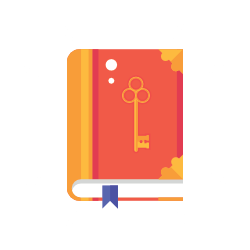
Let's stick with this driving metaphor for a second. Admittedly, you will learn from your failed exams. But learning is not the goal of the exam. It's purpose is only to test if you can already do something. And that's true for a lot of ear training exercises: they check if you can already do something.
For example, an app plays two notes and you need to tell what the distance between them is (i.e. the interval). Or your teacher plays a chord on the piano and you have to say whether that chord is major or minor. These recognition tests are easy to create and are a straightforward way to measure progress. I’m guessing that's why they’re so widespread. Any music class with ear training will quiz you through recognition tests.
However, as many musicians have found, they might get better at these tests, but it doesn't impact their playing. Very often, we’ll figure out tricks to do better and pass the exam. For example: 'Wait, this interval sounds quite dissonant, so it must be one of these three options…' Imagine someone taking a ‘color recognition test’ and employing the same strategy: ‘This color is sort of cold, so it can’t be yellow or orange. It must be green, purple or blue…’
It’s clear that if you’re using tricks like this to pass, you’re essentially still just guessing. You don’t actually own the material. And for ear training to be the most useful and actually impact your playing, you need to know the sound of musical elements on a deep and intuitive level, just like you can tell the difference between blue and yellow without much effort.
So how do you ingrain the material on that deeper level? What sort of practice is effective? The answer applies not just to ear training, but to efficient learning in general. Take a look at these activities:
- You read an article about Led Zeppelin
- You listen to the Beatles' Hey Jude
- You hear Iceland's national anthem before a football game
- You look at a chord diagram for an E minor chord
Now imagine doing the following activities. How is this different?
- You answer the question: who played drums in Led Zeppelin?
- You finish the sentence “Hey Jude, don’t….”
- You sing the first verse of Iceland's national anthem
- You play an E minor chord
The difference between these two lists of activities all boil down to one thing: active recall. Active recall occurs when your brain retrieves information stored somewhere in the dark recesses of your memory. You’re actively recalling that information. And as it turns out, this ingrains the information in your brain, making active recall a much more effective way to learn than what’s known as ‘passive review’, i.e. the first four examples above.
So what does active recall look like in ear training? What you need to do is this: listen to something, store it in your mind and then reproduce that sound by singing, humming or whistling it.
For example, listen to the sound of major third interval and then sing it. Or play a random note and then hum a perfect fourth. When you can produce an interval like this, recognising it is a breeze. The other way round? Not so much.
In short, whenever you are producing musical elements/sounds with nothing but your memory to fall back on, your brain is doing the heavy lifting of retrieving the correct information. As long as you’re producing sounds yourself, you’re doing the hard work that will grow your skills.
All this is not to say you should never do recognition tests. You should. But it's certainly not where ear training should start. We'll look at different ways to train your ears in the next section.
Before we dive into the exercises, let me quickly note that these three skills are just one way of categorizing things. And obviously, they can’t be perfectly separated. Listening in more detail (1) helps you recognise musical elements (3), which can help you reproduce it on your instrument (2).
These skills reinforce and strengthen each other. The point of identifying these three skills is to provide some clarity as to what you should be working towards. These are the skills that ear training exercises should help develop.
So what ear training exercises are there? And which of the three core skills will they help you develop? That’s what we’ll explore next. I’ve put the exercises into two groups. To do the first group of exercises you need little to no knowledge of music theory (though it sometimes does help).
The second group either involves theory or is about learning theory. For each exercise, I’ll explain what theory you need. Because this article is about ear training, it doesn’t make sense to cram in a complete guide to theory here, but I will explain some basic theoretical concepts so you know what you might have to look into. For the more advanced exercises involving theory, I’ll simply assume you know what I’m talking about.
- Learn riffs and melodies by ear
- Learn your own solos
- Free improvisation
- Figure out chords and progressions by ear
- Analyze melodies
- Singing and solfege
- Melodic dictation
- Analyze chords and progressions
- Recognition exercises
No Theory
Theory
Exercise 1. Learn Riffs and Melodies by Ear
 Use Your Instrument
Use Your Instrument No theory required
No theory requiredThe starting point for anyone looking to train their ears is to figure out songs by ear. Even if you’re only just getting started, you can practice figuring out slow, simple riffs and melodies by ear. If you don’t practice this, all the other exercises will have little impact on your playing. This is something that every great musician has done. From Jimi Hendrix to Bob Dylan and Joni Mitchell and from Jeff Buckley and Thom Yorke to John Mayer.
At first, learning songs by ear is about letting your hands get a feel for the fretboard (or whatever your instrument is). What do I need to do to make the pitch go up? How does it go down? By figuring out stuff by ear, this intuitive sense of what your hands need to do to produce a certain sound will become more and more tuned in and precise. You don’t need any knowledge of music theory for this. The beginning of ear training is theory-free.
I’ve written a step-by-step guide on how to learn riffs and melodies, check it out here.
I also created course called Make Your Ears Awesome: Kick-Starter, which helps you figure out real songs using interactive TAB. Try this song from the course below.
Hope figuring out that riff went well for you! If you want some more practice with note-by-note help, check out Make Your Ears Awesome: Kick-Starter. This course will help you figure out 24 songs by ear, exactly like this! You can try the first couple of lessons for free by getting the sample course:
For a bit more challenge, try out this next song by the Strokes! Instead of giving you help with each note, you'll fill in the entire riff on your own. When you think you've got the riff, check if you got all the notes right!
Listen closely to the riff and then grab your guitar to figure out the very first note. Next, fill out that note in this interactive tab and hit the 'check tab' button to see if you got the first note right. (It will turn green or red depending on if you got it right.)
Got that first note right? Keep going and see if can get the entire riff right!
Hope you enjoyed figuring out this song! For more practice like this, check out my course Make Your Ears Awesome. It will help you learn 51 riffs and melodies. Enroll in the sample course and get the first couple of songs for free.
Exercise 2. Learn your own solos
 Use Your Instrument
Use Your Instrument No theory required
No theory requiredYou've heard more music in your life than Beethoven or Mozart have. Combined. A weird, but wonderful fact of life since the invention of recorded music, mp3s, iPods and smartphones.
What’s interesting is that those thousands of hours of listening to music have filled your brain with a staggering amount of musical ideas. The challenge of playing your instrument by ear, is to be able to get all those ideas out. One great way breaking down this barrier between your head and your hands is to learn your own solos. Here’s what you do.
Put on a backing track or song you like and start a recording on your phone. Keep listening until some musical idea starts to form in your head. This might take a while, so just relax and try to be patient. When that idea starts to come up start singing or humming it. A phrase of ten seconds or so is perfect to start with.
Stop the recording and figure out how to play your own musical idea. It’s a good idea to avoid open strings, because this step is all about connecting the logic of the fretboard to the sound in your head (and open strings interfere in that process). Play it a few times to get it in your muscle memory and then play along to the recording you just made.
This is a great way to become better at playing the ideas in your head. As you do this exercise, you might find it fun to make the recordings longer and longer.
Another way to make this more challenging is this. Record a short phrase as you’ve done above. Now, instead of figuring out how to play it, first visualise how you would play it on your instrument. Which frets or keys would you need to press? I’ve described this in more detail in my article on Playing Guitar by Ear. Check it out here.
Exercise 3: Free improvisation
 Use Your Instrument
Use Your Instrument No theory required
No theory requiredIn many of the exercises below, we’ll explore quite some theory. And while all this theory can be very beneficial, there is a danger to it. We guitarists can become overly focused on positions and scale patterns and so on.
This is a complaint I hear regularly. People do their homework, but then after a while they find themselves stuck in ‘theory-based playing’. Scale patterns become ‘correct note maps’, instead of just another way to play a scale.
The solution to this ailment is to tune into your musical imagination. (For a more detailed explanation of how to do this, check out this guide on improvising on guitar.) Of course, falling back on your theoretical knowledge feels safe and comfortable. And for many of us, it's a habit. So it can be hard to let your musical imagination take over and call the shots instead. This is what why free improvisation is a great way to improve playing by ear. There are two ways you can practice this.
The first is to put on some random music (a playlist for example) and start playing along with it. Just play a note and if it sounds bad, play a different note. Simple as that. The beauty of this is that you can’t fall back on any theoretical knowledge you might have. All you really have is your ears. I’d also recommend that as soon as you feel like you’ve got a handle on the song (for example, you realise that the whole thing is in G minor), you move on to the next song. That moment where you’re not sure what is theoretically correct to play is what makes this exercise great. (Note: of course it’s not bad to realize what key you’re in you’re in, it’s good! It’s just not the point of this exercise.)
The second way of practicing this is by freely improvising with other musicians. When I was in music school, I was involved in a couple of free improvisation projects. They had a profound impact on my musicianship. By not being able to rely on any theoretical knowledge (which by that point was quite a lot), I had no other choice but to trust my intuition. It became a habit to let my inner ear guide me.
One challenge of free improvisation though is that ‘you can play anything’ can be a paralyzing assignment. ANYTHING!? So to make this more manageable, we came up with a game. First, make a list of titles for non-existent pieces you could play. For example, what do you think these pieces would sound like?
- Outer space is a great place for contemplation
- Airport Goodbye
- Google Maps sent me the wrong way, and now I'm lost
- Dying in the Dessert
- Jewellery Store Heist
Next, split up into two groups, where one group picks a title (I think we just put pieces of paper in a hat) and starts to play that non-existent piece, while the other group listens, looks at the list of titles and tries to figure out which one is being performed. This is a lot of fun.
I highly recommend you give free improvisation a try. There’s something very liberating about not thinking about theory and just playing. It just might be the best way to train yourself to rely on your musical intuition.
Exercise 4. Figure Out Chord Progressions by Ear
 Use Your Instrument
Use Your Instrument Almost no theory required
Almost no theory requiredJust like figuring out melodies by ear, I’ve found transcribing chord progressions to be immensely beneficial. For one, it trains you to listen to a recording in great detail. To find the right chords, we often need to listen to what all the instruments are playing, as they make up the harmony together.
Learning chords by ear also makes you listen so intently to the sound of certain harmonies, that they somehow become more ingrained in your system. You also become more familiar with these sounds because you’re hearing all these chords and progressions as they are used in an actual song, instead of sterile test where the chords are played by a robotic sounding piano. You want to train your ears for the situation you’ll be needing them the most: when you’re listening to or playing real music.
To get started with learning chord progressions by ear, check out my step-by-step guide here. It’s important to know though that figuring out chord progressions by ear is a bit more involved than learning melodies by ear, where you can just jump right in even if you’re a complete beginner.
For one, it really helps if you have some experience figuring out melodies and riffs by ear (exercise 1 above). You don’t need to be lightning fast at it, but if you’re still struggling a lot, it makes sense to focus your practice on learning melodies by ear for a little while longer.
Other than that, you need to know how to play the chords you’re trying to figure out. If you don’t know how to play a C#7 chord, you won’t be able to figure out a chord progression that uses that chord, right? So you could say: the more chords you know, the better.
But don’t hold off on learning chord progressions by ear because of a lack of chord knowledge. You can get started with my course Make Your Ears Awesome: Chord Progressions, which helps you figure out 55 songs by ear that only use open chords. Let's try out the first one right now.
Listen closely to the bass. Notice that up until 0:18 it only plays two different notes. It starts at 0:04 with one note, then switches to the second at 0:11, before returning to the first note at 0:15. Find those two notes, and you’ve found the two chords in this song! The chords you can pick from are: E, A and D.
Note that I’ve added ‘repeat’ to the second bar. This means you need to fill in the same chord as in the previous bar.
If you enjoyed this, feel free to keep going with the rest of the course. The first couple of songs are free.
Before we move on, a quick note about your audio setup. Especially when it comes to figuring out the bass by ear, it matters how you listen to music. On a pair of laptop or phone speakers, it can be really hard to hear the bass at all, making things much more challenging. Using headphones helps, both because the sound tends to be better and because it helps you focus.
You don’t need a super fancy pair of headphones. Even the relatively affordable Apple earbuds (i.e. the ones with wires) are a vast improvement over laptop speakers. Some things to consider: so-called 'closed back' headphones tend to have an extended low end, which can make the bass easier to hear. By contrast, open back headphones have a wider soundstage. This means it can be easier to pick out the different instruments on a track. In the end though, it's a matter of personal preference, so try different things and see what you like!
Chord Theory
I’ve listed this exercise as ‘no theory required’, because I don’t want you to hold off on figuring out chords by ear because you don’t know a lot of theory. And as we’ve seen above, you don’t absolutely need theory. But that doesn’t mean though that music theory won’t help you figure out chords by ear. Here’s a brief overview of the most important things that will help you.
First, it helps a lot to know how to play the most important chord types in all keys. As we’ve seen, you need to know how to play the chord you might run into. Ideally, you would know how to play the following chord types in all keys:
- Major
- Minor
- Power chords
- Dominant
- Major Seventh
- Minor Seventh
- Half Diminished
- Diminished
Knowing these chord types will be plenty for at least 9 out of 10 songs. Side note: this is exactly what you’ll learn in my course Guitar Chord Bootcamp. Check out the details here.
Secondly, it’s useful to know how chords are constructed, because every single note you pick out will give you valuable information about what chord you’re dealing with. (See the detective approach.)
Third, learning about diatonic harmony will help you understand which chords ‘fit together’, allowing you to make educated guesses about what you’re hearing. (See the architect approach.)
If you don’t know about chord construction and diatonic harmony, please don’t rush out to learn about these topics though. It makes more sense to first gain some experience figuring out chords using just your ears and an instrument. After that, be sure to check out exercise 8: analysing chords and progressions, which is a great way to get a handle on the theory.
Exercise 5: Figure out and analyse riffs and melodies
 Use Your Instrument
Use Your Instrument
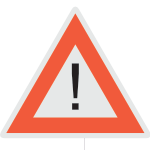 Theory required
Theory required
Think of this one as the advanced version of exercise 1. In addition to figuring out how to play a melody or riff, you also analyse it theoretically. So why is is this useful? Well, in addition to training your ability to hear in detail (skill #1) and play by ear (skill #2), you’re also linking the sound of musical elements to musical ‘labels’ (skill #3). Here are some questions you might ask:
- What scale does the song use?
- Which scale degree does it start on?
- Are there any notes that stand out? Why?
- Which chord note are they on?
So what would that look like? Let’s take a riff that’s so famous that football stadiums full of people sing it: Seven Nation Army. This is not the place to explain theory or how exactly to figure this stuff out, but here are a few things we might notice:
- The riff starts on an E, the root note.
- The riff uses these scale degrees: Root, minor third, root, minor seventh, minor sixth, perfect fifth.
- The riff uses the E minor aeolian scale (also known as natural minor)
- The riff ends on a B, which is the perfect fifth. This gives the ending of the riff a certain tension, making it want to go back to the root note.
This is a great way of getting into theory, because you’re working with actual music, instead of dry, theoretical concepts. You’re starting with sound.
Let's try another example, this one taken from my course Music Theory From Scratch. We'll analyse the main riff from this track by The Shins.
This might be tricky if you've never done it before, but just take it one note at a time! One thing that's useful to know: the seventh fret on the A string is an E...
Exercise 6: Singing and Solfège
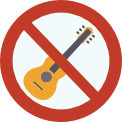 No Instrument
No Instrument
 Theory required
Theory required
As we saw in chapter 6, 'active recall’ is the holy grail of effective learning. When we make our brain do the hard work of recalling information stored in our memory, we make the most progress. This is why singing exercises are so incredibly effective. They’re tough. They require a lot of concentration. But they work.
If you prefer not to sing, or if you’re afraid your landlord will leave an eviction notice on your door after overhearing you practice, humming or whistling quietly is also perfectly fine. As long as you make some sort of noise with your mouth.
The goal of these singing exercises is to get better at recognising musical elements (3). When you’re able to sing these elements or produce them with your mouth in any way, it becomes much easier to recognise them. So, what elements should you be able to recognise? As a start, the most important ones are:
- scales
- intervals
- scale degrees
- chord quality
Scale Singing Exercises
To start, we’re going to sing the major scale in a couple different ways. You’ve heard the major scale before. It’s what people sing when they go "Do, Re, Mi, Fa, So, La, Ti, Do". Here’s how to play it on guitar:

Guitarists: you might notice that I haven’t added a fret number so you know where on the neck to play this. That’s on purpose. You can play this in any fret and it will still be the major scale, cool right? If you hate not having instructions though, just start with the lowest note in the eight fret and you’ll be playing the C major scale.
Scale Singing Exercise #1
The first exercise is to sing the scale up and down. Start by playing along on your guitar or piano to make sure you’re getting all the notes right. What’s even better though, is to find a recording that you can sing along to. (Or just quickly make a recording on your phone. It’s just for practice, not to win a grammy award.) A recording helps you keep focused on the singing and it forces you to follow along.
To stay aware of where you are in the scale (which is important for the next step), sing the scale in numbers:
1 2 3 4 5 6 7 8 7 6 5 4 3 2 1
In our guitar diagram, the numbers would look like this:
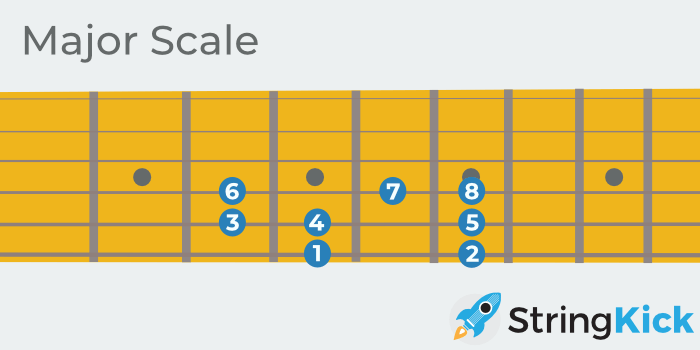
For guitar and bass players, it’s very beneficial to also imagine what this would like like on the fretboard and which finger you’d use. So while you’re singing the scale in numbers, close your eyes and visualise the pattern above. With each note you sing, touch your thumb with the finger you’d normally fret that note with.
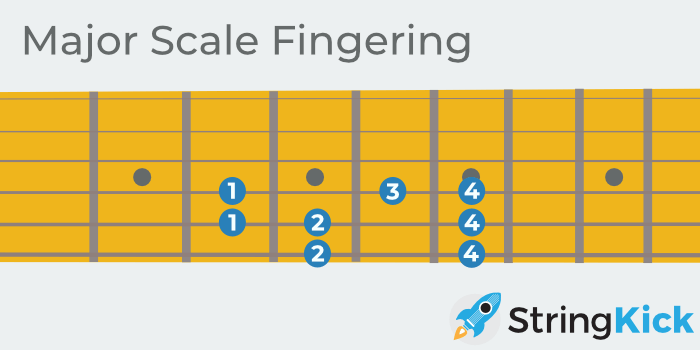
(1=index, 2=middle, 3=ring, 4=pinky)
By doing this, you’re supercharging your practice by working on several memories at once: your aural (sound), visual (scale pattern), tactile (feeling in your fingers) and theoretical (number in the scale, a.k.a. 'scale degree’).
Once you get reasonably comfortable with this, it’s time to put your instrument or recording away and sing the scale without any help. In the beginning you might notice this requires a lot of concentration, but with practice, it will become more and more ingrained and automatic.
Scale Singing Exercise #2
The next exercise is similar to the last, but a little more involved. Instead of the singing the scale up and down, your mission is to sing the following pattern:
1 1 2 1 1 2 3 2 1 1 2 3 4 3 2 1 Etc.
For an example of how this works, check out this video:
Everything from the last exercises applies here too:
- Sing the numbers
- Guitarists and bass players: imagine the fretboard pattern while you sing and tap your fretting fingers and your thumb accordingly
- Sing along to a recording first, then practice without help.
Scale Singing Exercise #3
For the next exercise, your goal is to sing this pattern:
1 2 1 3 1 4 1 5 1 6 1 7 1 8
Practice with a recording or your instrument first, then try to do it without help!
Scale Singing Exercise #4
If you're getting pretty comfortable with exercise #3, check out this next one. It's the same as exercise #3, but the other way round.
1 8 1 7 1 6 1 5 1 4 1 3 1 2 1
Interval Singing Exercises
In the last two scale singing exercises, you might have noticed you were essentially singing intervals. An interval is the distance from one note to another. And you were practicing singing the distance from the first note in the scale, the root note, to every other note. The next step is to start mixing these up. So play a random note and give yourself the assignment to sing, for example, the fifth note in the scale. 1-5-1.
To make this a little easier at first, you can start by singing up the major scale until you arrive at the fifth note in the scale. So you’d sing: 1-2-3-4-5-1, 1-5-1
Once you reach this level, it’s also time to learn more about intervals. On guitar or piano, we can think of distances as the number of frets or the number of keys between one note and the next. But in music, we have given every distance its own name. Here’s an overview of the distances in the major scale. (Note: one guitar fret is the same as one piano key or one half step).
When you’re doing this exercise, it’s useful to keep in mind that when you sing 1-5-1, you’re singing a perfect fifth interval. Or when you sing 1-6-1, you’re singing a major sixth interval.
More scale and interval exercises
Once you’ve gotten a handle on the major scale, your next move is to repeat all the steps above for the natural minor scale. The natural minor scale is constructed differently than the major scale:
Doing all these exercises with both the major and natural minor scale will teach you the sound of 10 out of 12 intervals. Pretty good score, right?
The two intervals we’ve missed are the minor second and the augmented fourth, also known as the diminished fifth or tritone. To practice these as well, do the exercises above with the so called ‘chromatic scale’. This basically means: all twelve notes. (Note: forget about singing the scale degree numbers though for the chromatic scale!)
That’s it! If you master these exercises, you’ll notice that the recognition exercises (exercise #9 below) will be much, much easier.
Chords
That leaves us with just one more topic: chords. You can practice this by singing the individual notes a chord is made up out of. This what we call an arpeggio. You can think of it as an ‘incomplete scale’, because you’re skipping a few of the notes in the scale. For example, to sing a major chord arpeggio you’d sing the root, major third and perfect fifth. Here’s an overview of a few common chord types:
- Major: root, major third, perfect fifth
- Minor: root, minor third, perfect fifth
- Major seventh: root, major third, perfect fifth, major seven
- Minor seventh: root, minor third, perfect fifth, minor seven
- Dominant seventh: root, major third, perfect fifth, minor seven
- Minor major seventh: root, minor third, perfect fifth, major seven
Again, practice this first by singing along to a recording, but then practice singing it all by yourself. You can even do this when you’re in the shower or waiting for the bus.
Exercise 7: Melodic dictation
 No Instrument
No Instrument
 Theory required
Theory required
Figuring out songs by ear (both melodies and chords) is a great way to train your ears. In a few of the exercises above, you use your instrument to work out what you’re hearing, in part through a process of trial and error. Melodic dictation is the process of figuring out a song by ear without your instrument, making it quite a bit more challenging.
This exercise is mostly about ‘recognising musical elements (3). It’s about hearing a melody and ‘understanding' what it is. Hearing the underlying musical logic. It's a very useful skill to be able to jot down a melody you hear. The focus and concentration it requires also makes it effective practice. It’s hard work, but worth it.
Don’t practice this though until you’ve gotten pretty good at figuring out songs with your instrument. Without that experience melodic dictation will be needlessly difficult.
You also need to be familiar with how scales are constructed, particularly the major scale (ionian) and the natural minor scale (aeolian). Be sure to figure out and analyse plenty of melodies as we’ve seen in exercise 5.
For years, I found melodic dictation very hard. But as I found out, my approach was making things much harder than they needed to be. I used to think of a melody as basically being a series of note names: E, F#, B, A etc. To figure out these notes, I’d try to analyse the distance (the interval) between every two notes. So I’d listen to the first two notes and think ‘that sounds like a major second’. Then I’d listen to the second and third note and ask myself ‘is that a minor third interval?’. This approach is like trying to read a sentence by looking at every individual letter, instead of taking the sentence as a whole. You’re ignoring the logic, structure and meaning of the language.
So, what’s the better approach? How can we use the structure and logic of a melody to make things easier?
First, a melody uses a scale. Nine times out of ten, this is either the major scale or the natural minor scale. Knowing which scale a melody uses, gives us a framework. It limits our options. Instead of twelve possible notes, we now have seven. This already makes things a lot easier.
Second, we need to think of a melody in terms of scale degrees instead of note names. So, instead of thinking ‘this is an F#, this is an A’, we need to think ‘this is the root note, this is the minor third’. This helps us to know ‘where we are’ in the scale. It helps us make sense of what we’re hearing.
If you have little to no experience thinking in terms of scale degrees, I realise this might sound pretty vague. Be sure to do plenty of analysis exercises (#5) to become more comfortable with it. If you’re feeling comfortable with scales and scales degrees though, here's quick and dirty guide to figuring out a melody by ear, without your instrument.
- Does the melody use a minor or major scale? You can often tell quite quickly just through the general sound of the song. This is also where your experience figuring out songs by ear comes in.
- Listen closely to the entire melody and try to figure out which note is the root. This is often the first or the last note. With some experience, you’ll learn to recognize the tensionless, ‘at home’ sound of the root note.
- Knowing this, you now have a good guide of which scale degrees you can expect. If the first note is not the root note, figure out which scale degree it is by comparing it to the root note.
- Next go at it note by note. Each time, first listen to whether the melody is simply going to the next note in the scale (meaning it goes up or down a minor or major second) or if it’s making a larger leap. If it’s making a step in the scale, you’ll know what scale degree it is. If it’s a larger leap, listen to what interval you think the leap is. Verify that this is possible within the scale. For example, when you’re figuring out a major melody and a minor third leap from the fifth is somewhat unlikely, because it would make us land on the minor seventh, where we’d expect a major seventh. Of course, it's also possible that a note is not part of the scale. This might sound like it makes things difficult, but those notes are often the easiest to identify. If a note is outside of the scale, our ears usually go 'wow, what the heck was that?'.
As you practice this more and more, you'll find that certain patterns will become super familiar to you. For example, for many people the sound of the major seventh scale degree going to the root is so recognisable that they don't even have to think about it. With practice, this will happen with more and more patterns in the scale.
Exercise 8: Analyze chords and progressions
 Use Your Instrument
Use Your Instrument
 Theory required
Theory required
In exercise 4, we discussed learning chord progressions by ear. To maximize the benefits of this exercise, it’s a good idea to also analyze the chords. This teaches you to associate the sounds of certain harmonies to the music theory ‘labels’ that we use.
Here’s an example. I remember discovering ‘There There’ by Radiohead and really liking the chord progression in the outro. When I analysed it, I learned it started with a B minor chord and a D minor chord. I found out I really liked that sound of two minor chords that are a minor third apart (a.k.a. three frets apart - another example would be A minor and C minor). I then started to hear that sound in more and more songs, such as 'Light my Fire' by the Doors and 'Down is the New Up' by Radiohead.
A similar thing happened after I first learned what a twelve bar blues progression was. Once you know what a certain musical element, thing or phenomenon is called, you’ve made it part of your conscious mind and you start to hear it everywhere.
So what should you analyze exactly? Here are the two biggest things:
1. Chord quality
If you’ve done exercise #4, you already have experience figuring out what chord type you’re dealing with, i.e. whether a chord is major, minor, dominant, diminished etc. When I started figuring out songs by ear, I did this through trial and error. I’d just play a chord and see if it sounded the same as the recording. This is a great way to start out, but at some you also want to understand why a chord is a certain chord type. To do so, we need to analyze the building blocks of the chord. We need to ‘label’ all the individual notes that make up the whole chord.
For example, you might hear the bass is playing an E while a trumpet is playing a G# and the violin plays a D. The bass, the lowest note, tells us that E is the root note. The trumpet’s G# is a major third, making this chord major. The D in the violin adds a minor seventh, which means we’ll call this chord a dominant chord. Chord name: E7. (To learn how chord names work, check out this guide.)
Of course, you can often find all these notes in one instrument like a guitar or piano, but be sure to check other instruments too. The harmony is made up of all the notes that are being played at the same time, regardless of instrument.
2. Roman numeral analysis
When talking about music, musicians will often call a series of chords a ‘two-five-one progression’ or a ‘one-four-five progression’. You might have seen this before in writing as ‘ii-V-I’ or ‘I-IV-V’. So what are musicians referring to with those numbers? What do these Roman numerals mean?
In exercise 5 and exercise 7, we saw that one important aspect of understanding a melody is to look at scale degrees. For example, a melody might start on the root, go to the minor third, to the perfect fourth and back to the root (as is the case with the first notes of Smoke on the Water, for example). In short, we use labels like perfect fifth and minor third to indicate the scale degree of a note.
Chord progressions are also based on a scale. In fact, we can build a chord on each scale degree. For the C major scale that would get us these chords:
We use the Roman numerals to indicate on which scale degree the chord was built. So in the scale of C, ii-V-I means Dm-G-C and I-IV-V means C-F-G. Here’s an overview:
In short, these Roman numerals are a shorthand way of talking about how chord progressions are constructed. But how does this make your ears better? There are two ways.
Firstly, Roman numeral analysis teaches you about ‘diatonic harmony’. If you play around with the chords in the chart above, you’ll notice that they sound like they somehow belong together. That’s because all these chords are constructed from notes in the C major scale. We call a chord progression that only uses notes from a single scale ‘diatonic’. This is useful, because, most chord progressions are diatonic. Diatonic is normal. Nine times out of ten, a song will be diatonic. So when you know the sound of diatonic chord progressions, it becomes much easier to figure out chord progressions simply by listening to them. Also, all the moments where a chord is ‘non-diatonic’, meaning it uses a note from outside the scale, will jump out you immediately.
That brings us to the second way Roman numeral analysis helps your ears. It allows you to see, hear, recognize and understand all sorts of patterns in the chord progression you encounter. For example, in jazz ii-V-I progressions are used all the time. In blues music, I-IV-V are super common.
Let's take a look at a concrete example, with a lesson from Music Theory From Scratch. We'll analyse the chords in this tune by The Cure.
This song is in the key of A, meaning that the A chord will be the Roman Numeral 1 chord. Can you figure out the other chords?
Exercise 9: Recognition tests for intervals, scale degrees, scales and chords
 No Instrument
No Instrument
 Theory required
Theory required
I’ve mentioned recognition tests a few times in this guide and never with much excitement. It’s unfortunate that they seem to be the default way of training your ears, while they really aren’t the most effective way of going about it. As we saw in chapter 6, active recall is the holy grail of learning and these recognition tests don’t involve any active recall.
Another issue is that these exercises always train you outside of a musical context. They aren’t part of a song. The exercises are a sterile, isolated, laboratory approach. Meanwhile, we need to train our skills for situations where there is a ton of musical information going on at once. And that’s why I’ve pointed you towards all the other exercises above first.
That said, these recognition exercises have their place is ear training. Some people like these exercises precisely because they are used outside a musical context, because it's less tiring. After practicing with real music for a while, it can be a nice change. These exercises are also a good way of measuring progress. For example, you might find that you can easily recognise some intervals or chords, but not others. You might realise that you keep mixing up perfect fourths and perfect fifths. This tells you where you need to do more singing exercises. In short, these exercises can certainly be useful, as long as they are part of a 'balanced diet' of ear training practice.
CHAPTER 8
More Resources
A few years ago, I started this site to help guitarists to become a better musician. I hadn’t realised that that meant I would be writing a lot about ear training.
Here is a quick overview of all the articles, courses and other practice materials related to training your ears.
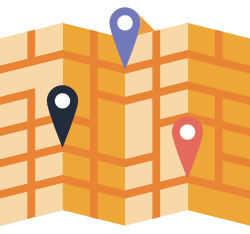
Guides and Articles
How to Learn Riffs and Melodies by Ear A step-by-step guide to how you actually figure out a melody or riff using your ears and your instrument. Check it out here!
How to Learn Chord Progressions by Ear The second part of the article above, with a step-by-step guide explaining how to figure out the chords to a song. Click here to check it out!
Guitar Ear Training: 9 ways to train your ears A guide to 9 ear training exercises, specifically for guitar players. Check it out here!
How to Play Guitar by Ear An in-depth guide to how you learn to play whatever you hear. Read it here!
How to Improvise on Guitar This guide explains how improvisation works, how to get started with it and how you can get better at it. Read more here!
Why Should You Learn Music Theory? A quick article about music theory. Why is it important? When should you learn music theory? And what's the right approach? Read the article here!
Courses
Make Your Ears Awesome: Riffs and Melodies This course helps you learn how to figure out riffs and melodies by ear using interactive TAB.
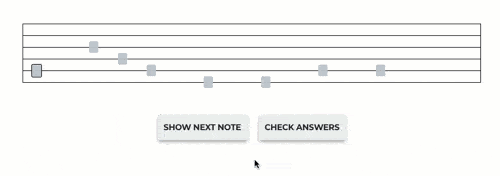
The course takes you through 51 real songs that gradually become more challenging. If you're interested, you can read more about the course here. You can also go ahead and try the first couple of lessons for free by enrolling in the sample course below.
If you're interested, you can try the first five songs for free by enrolling in the sample course below.
Make Your Ears Awesome: Chord Progressions This course is all about figuring out chord progressions by ear. Like the course above, it uses real music, so your ears learn to dissect the sound of the songs you listen to every day.
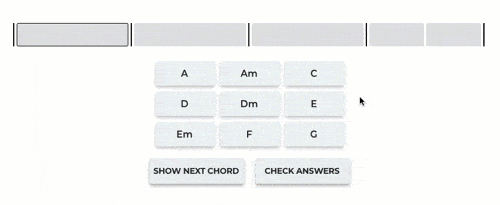
Guitar Chord Bootcamp This course is not about ear training, but I'm mentioning it because it will expand your 'chord library' dramatically, which is really useful when you start figuring out chord progressions by ear.
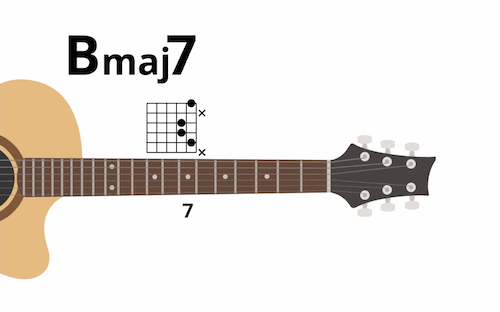
Simply put: you can't figure out a chord like Ab7 or Cm7 by ear, if you don't know how to play the chord in the first place. Check out the details here!
Thoughts? Questions?
I hope this guide and the above resources help you train your ears and become the musician you want to be. I’d love to keep improving this guide and create other cool stuff for musicians like you, so if you have any thoughts or questions, let me know! Simply send me an email: just(at)stringkick.com.

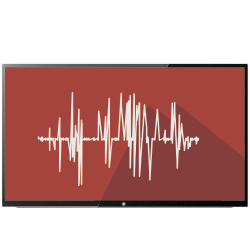


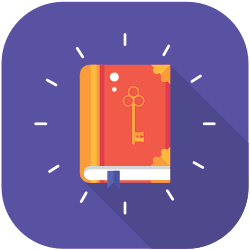

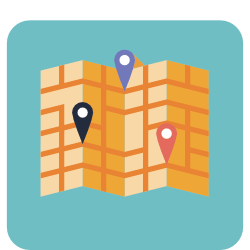



![Title image for How to Learn Songs by Ear [Complete Step-by-Step Guide]](https://www.stringkick.com/wp-content/uploads/2015/04/Learn-Songs-By-Ear-Orange.png)
![Title image for How to Play Guitar by Ear [Step-By-Step Plan]](https://www.stringkick.com/wp-content/uploads/2015/04/Play-by-Ear.png)
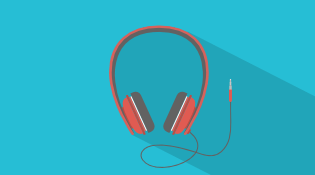
![Title image for The Major Scale on Guitar [Simple Explainer]](https://www.stringkick.com/wp-content/uploads/2023/03/Major-Scale-Guitar.png)
![Title image for How to Improvise On Guitar [Easy Guide]](https://www.stringkick.com/wp-content/uploads/2019/05/Improvise-Purple-315x175.png)

